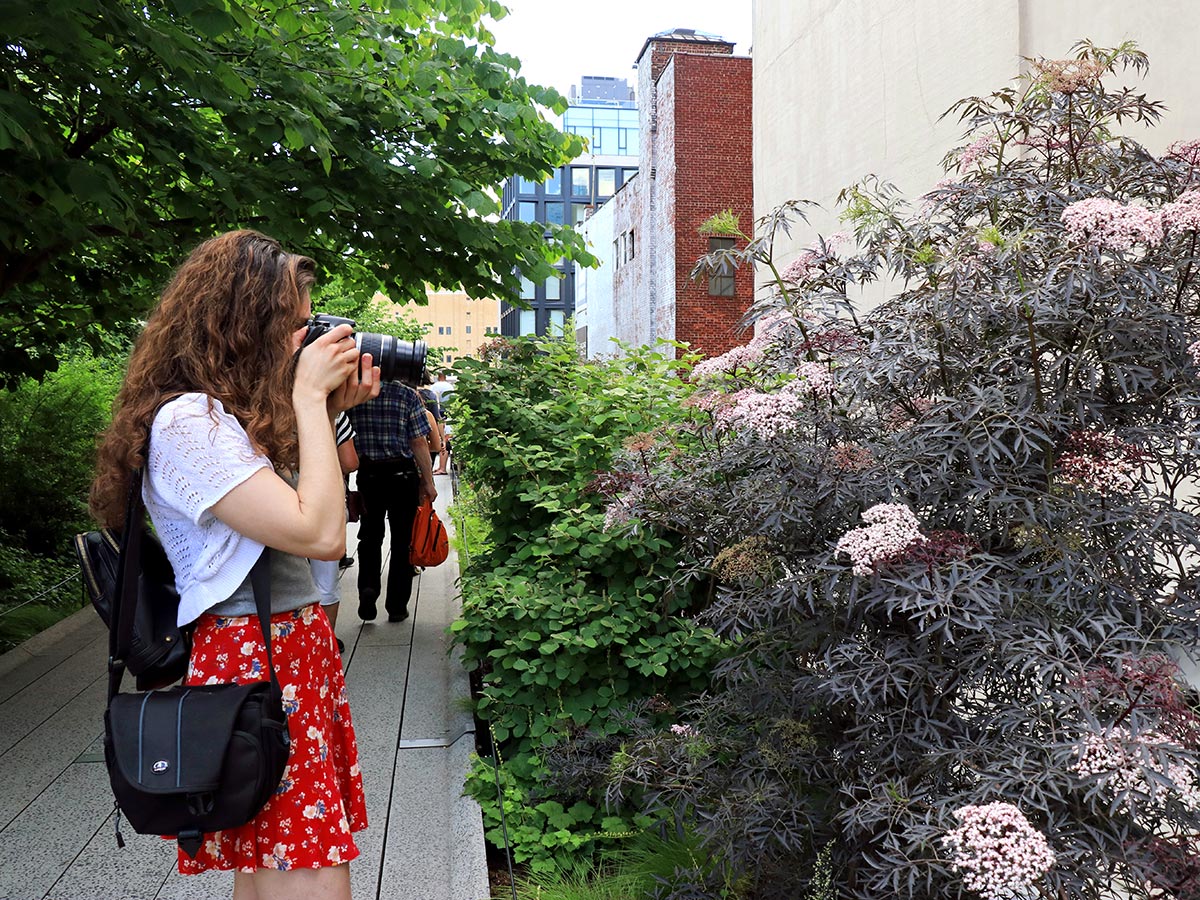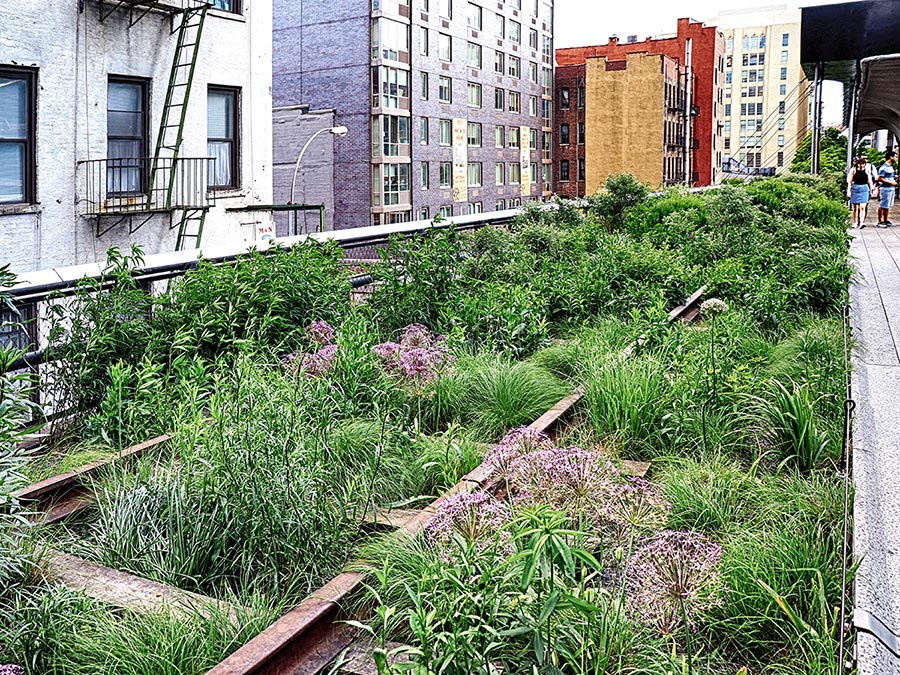Walking the Rails

Carolyn focuses her camera on Black Lace elderberry in the Chelsea Thicket section of New York City’s High Line. PHOTO Laura Brandt
In her teenage years, my daughter used to call me a “plant freak.” Now, I’m waiting for her to meet me on the Diller – von Furstenberg Sundeck, part of New York City’s High Line, where we will explore and delight in an urban garden together.
It’s a warm, early June day, and I can hear robins chirping and bees buzzing amid the swaying tall grasses. The sunshine warms my face, butterflies float by, and the smell of spring blossoms fills the air; hard to believe this botanic dream is a reality in Manhattan’s Lower West Side.
Created on a former New York Central Railroad spur, the area lay dormant for nearly three decades before becoming the beautiful elevated walkway and garden it is today. While Carolyn has walked the High Line before, I have not. A graphic designer, she works a few blocks away and appreciates the inspiration it provides while sheltering her from the busy world below.
As a nature photographer and former landscape designer visiting from Pennsylvania, I’m excited to explore this railroad-turned-public park for the first time. We are perhaps even more intrigued because of a family connection: My father and grandfather both worked for New York Central Railroad Company.
We set out with our cameras to admire the plantings along the roughly mile-and-a-half pathway 30 feet above street level, which is maintained and programmed by Friends of the High Line in partnership with the New York City Department of Parks & Recreation.
A Communal Stage
As we turn the corner around the 14th Street Passage, we see an intriguing field of pure white floating discs suspended on flexible metal — like lily pads swaying in a gentle wind. This temporary digital installation, “The Meadow,” is a collaboration between Google and Refinery29, the New York City media and entertainment giant. It projects photos taken on Pixel phones onto the white discs. Each year, High Line Art commissions artists to create provocative installations on and around the High Line.
As such, this is a place to see and be seen. We observe “costumed” people walking down the High Line as if on an elevated fashion runway. Like many urban greenways, the High Line is a micro melting pot, and we hear languages from all over the world. But we are somewhat surprised to meet several New York natives as well. An older couple who had lived in New York, moved away, and returned tells us they came back because they love the energy of the city — including the High Line. They often walk its length to see what’s in bloom.
Somehow it seems easier to start conversations up here, high above the street on this communal stage, rather than down below.
More Natives
times, our experience is mostly peaceful. Carolyn and I wander together, appreciating the gardens’ textures and shapes. The colorful blossoms and beautifully designed plantings mesmerize us and beg to be photographed — especially set against the urban backdrop of tall buildings and steel rails.

Exposed rails can still be seen peeking through green foliage; their stark lines contrast the curving plant life yet echo the hard architectural angles of the cityscape beyond. PHOTO Laura Brandt
Piet Oudolf, the influential Dutch garden designer, strategically laid out the original naturalistic design, which is carefully curated by talented gardeners. Of the over 500 plant species on the High Line, roughly half of the biodiverse plantings are native to the U.S. (a full plant list is available online). They bring beauty, pollinators and heat relief to the city, as well as filtering pollutants from air and rainwater.
We (and our cameras) are particularly drawn to native Whitespire gray birch (Betula populifolia), Allegheny serviceberry (Amelanchier laevis), Virginia rose (Rosa virginiana), white wild indigo (Baptisia alba), Black Lace elderberry (Sambucus nigra f. porphyrophylla ‘Eva’) and purple prairie clover (Dalea purpurea).
As we enter the area called the Flyover, we walk through a sort of a magnolia alley. This section lies between two buildings where trees grow upward to catch the light. Although the Flyover forest includes shadbushes (Amelanchier spp.), redbuds (Cercis canadensis), sumacs (Rhus spp.) and sassafras (Sassafras albidum), the real drama comes from the use of bigleaf magnolias (Magnolia macrophylla).
Other magnolias artfully blend into the canopy, including Ashe’s magnolia (M. ashei), umbrella magnolia (M. tripetala), and Green Shadow sweetbay magnolia (M. virginiana var. australis). When they’re in bloom, it’s impossible to pass by without snapping an image.
A Zaha Moment
Walking towards the north end in West Chelsea, we are confronted by the recently constructed Zaha Hadid luxury apartment building with fabled $50 million penthouses. We’re both intrigued with this futuristic-looking building — even more so because Carolyn had studied Hadid, the award-winning female architect, in art school. We imagine what the view must be like, looking out at the High Line from this modern, curvaceous masterpiece.
At the end of the day, we find an outdoor eatery with a beautiful view of the Hudson River and share our images. Sitting there, enjoying gentle river breezes and Carolyn’s good company, I know I’ll be back — to visit my daughter, of course, but also to visit the High Line. With ever-changing seasons and art installations, it has the power to captivate year-round.
Laura Brandt lives and gardens in Bucks County, Pennsylvania, an hour-and-a-half train ride to New York City, where she enjoys photographing gardens, flowers, people and food. Her work can be found at laurabrandt.zenfolio.com and on Instagram at @laurabrandtphoto.

